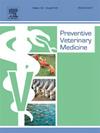估计美国一次模拟非洲猪瘟暴发的抽样和实验室能力
IF 2.2
2区 农林科学
Q1 VETERINARY SCIENCES
引用次数: 0
摘要
非洲猪瘟病毒(ASFV)传入未受感染国家可影响经济和动物福利。快速发现和控制疫情有助于成功根除并促进业务连续性。我们开发了一个模型来确定ASFV引入美国后的样本数量、样本收集器、实验室能力和处理时间。我们模拟了ASFV在一个猪群密集的州的传播,在150天内产生了27次(范围= 1-68)次爆发,产生了616次(范围= 1-15,011)次抽样事件,总共抽样了3068个(范围= 7-69,118)个猪舍。考虑到每天的工作时间、采样和驾驶时间以及有和没有血液样本汇集的实验室能力,我们计算了所需的样本采集员总数。样本包括每个谷仓31份血液样本和5份口腔液样本,分别相当于84,830份(范围= 52 - 2066,831)和14,195份(范围= 10-345,590)血液和口腔液样本。防止采样延迟所需的样本采集人员中位数从136人到367人不等,在最严重的流行病情况下,从833人到3115人不等。值得注意的是,排除停机时间(使采样器无法在24或72 h内访问其他农场)后,所需的样本采集数量减少了28% %至75% %,而从血液样本转向口服液样本将这一数字减少了47% %至75% %。在实验室日处理能力为1000个样本的情况下,无池处理样本的中位数天数为92天,最长为5.7年。我们证明需要每天将10062份(范围= 2-67,940)未处理的样品重新分配到其他实验室,以防止处理延误。我们的研究解决了有效组织资源以管理潜在的ASFV爆发的挑战,提供了有关美国一个人口稠密的猪区所需的样本收集者数量和实验室能力的信息本文章由计算机程序翻译,如有差异,请以英文原文为准。
Estimating sampling and laboratory capacity for a simulated African swine fever outbreak in the United States
The introduction of African swine fever virus (ASFV) into uninfected countries can impact economic and animal welfare. Rapid detection and control of the outbreak contribute to successful eradication and promote business continuity. We developed a model to determine the number of samples, sample collectors, laboratory capacity, and processing times following an ASFV introduction into the U.S. We simulated the spread of ASFV in one densely populated swine state, generating a median of 27 (range = 1–68) outbreaks in 150 days, resulting 616 (range = 1–15,011) sampling events with a total of 3068 (range = 7–69,118) barns sampled. We calculated the total sample collectors needed, considering daily working hours, sampling and driving time, and laboratory capabilities with and without blood sample pooling. Samples included 31 blood samples and five oral fluid samples per barn, which equal 84,830 (range = 52–2066,831) and 14,195 (range = 10–345,590) blood and oral fluid samples, respectively. The median number of sample collectors needed to prevent sampling delay varied from 136 to 367 and, in the worst epidemic scenarios, from 833 to 3115. Notably, excluding downtime–which prevented the sampler from visiting additional farms for 24 or 72 h–reduced the number of sample collectors needed between 28 % and 75 %, while switching from blood to oral fluid samples reduced this number between 47 % and 75 %. At a laboratory processing daily capacity of 1000 samples, the median days for sample processing without pooling were 92 days, with a maximum of 5.7 years. We demonstrated a need to redistribute 10,062 (range = 2–67,940) unprocessed samples daily to other laboratories to prevent processing delays. Our study addresses the challenge of efficiently organizing resources for managing a potential ASFV outbreak, providing information about the number of sample collectors and laboratory capacity needed for one densely populated swine region in the U.S.
求助全文
通过发布文献求助,成功后即可免费获取论文全文。
去求助
来源期刊

Preventive veterinary medicine
农林科学-兽医学
CiteScore
5.60
自引率
7.70%
发文量
184
审稿时长
3 months
期刊介绍:
Preventive Veterinary Medicine is one of the leading international resources for scientific reports on animal health programs and preventive veterinary medicine. The journal follows the guidelines for standardizing and strengthening the reporting of biomedical research which are available from the CONSORT, MOOSE, PRISMA, REFLECT, STARD, and STROBE statements. The journal focuses on:
Epidemiology of health events relevant to domestic and wild animals;
Economic impacts of epidemic and endemic animal and zoonotic diseases;
Latest methods and approaches in veterinary epidemiology;
Disease and infection control or eradication measures;
The "One Health" concept and the relationships between veterinary medicine, human health, animal-production systems, and the environment;
Development of new techniques in surveillance systems and diagnosis;
Evaluation and control of diseases in animal populations.
 求助内容:
求助内容: 应助结果提醒方式:
应助结果提醒方式:


